Miocene Biogas Generation System in the Carpathian Foredeep (SE Poland): A Basin Modeling Study to Assess the Potential of Unconventional Mudstone Reservoirs
Abstract
1. Introduction
2. Miocene Carpathian Foredeep Basin: Geological Background
- Complex 1: Lower Badenian, composed of clastic, mostly clayey, local (in the paleo valleys) sandy deposits.
- Complex 2: Lower Badenian evaporates.
- Complex 3: Upper Badenian fine-grained deposits and the lowest part of the Machów Formation, which are dominated by mudstones and shales with minor inclusions of sandstones.
- Complex 4: Upper Badenian turbiditic formation and lower part of Machów Formation, mostly composed of heterolithic fined-grained deposits with local occurrence of rather thin beds of sandstones.
- Complex 5: Upper Badenian turbidite formation II and middle part of Machów Formation, composed of turbiditic fans and heteroliths. The complex is much more sandy than Complex 4.
- Complex 6: Upper Badenian–Sarmatian deltaic fans and deltaic overburden complex and upper part of Machów Formation, containing a high grade of medium- to coarse-grained deposits.
3. Model of Miocene Biogenic Gas Generation System: Methodological Approach
3.1. Miocene Biogenic Gas System
3.2. Spatial Distribution of Lithological Variability and Organic Matter Content
3.3. Paleothermal Model of Study Area
3.4. Integration and Calibration of Basin Model Components
4. Dynamic Modeling of Biogenic Gas System: Results and Discussion
4.1. Progress of Petroleum Processes on a Basin Scale
4.2. Progress of Hydrocarbon Generation Processes in Particular Zones and Depth Intervals of Miocene Basin
- The northern part of the basin, at the foreland of the Carpathian Overthrust front, in deltaic facies (Complex 5) recently buried at about 1100-m depth.
- The northern part of the basin, at the foreland of the Carpathian Overthrust front, in fine-grained facies (Complex 3) recently buried at about 2000-m depth.
- The southeastern part of the basin, beneath the overthrust Carpathian Orogen, in fine-grained facies (Complex 3) recently buried at about 3700-m depth.
4.3. Analysis of Hydrocarbon Accumulation Opportunities in Mudstone–Claystone Formations from Particular Zones and Depth Intervals of the Miocene Basin
4.4. Progress of Gas Generation and Accumulation in Selected Sedimentary Formations
5. Conclusions
Author Contributions
Funding
Acknowledgments
Conflicts of Interest
References
- Berent-Kowalska, G.; Peryt, S.; Dziedzina, K.; Jurgaś, A.; Roman, W.; Kacprowska, J.; Gilecki, R.; Parciński, G.; Boczek-Gizińska, R.; Szymańska, M.; et al. Energy Statistics in 2017 and 2018; Ministry of Energy, Energy Department: Warsaw, Poland, 2019; p. 83. [Google Scholar]
- Wang, H.; Ma, F.; Tong, X.; Liu, Z.; Zhang, X.; Wu, Z.; Li, D.; Wang, B.; Xie, Y.; Yang, L. Assessment of global unconventional oil and gas resources. Pet. Explor. Dev. 2016, 43, 925–940. [Google Scholar] [CrossRef]
- McGlade, C.; Speirs, J.; Sorrell, S. Unconventional gas—A review of regional and global resource estimates. Energy 2013, 55, 571–584. [Google Scholar] [CrossRef]
- Nguyen-Le, V.; Shin, H.; Little, E. Development of Shale Gas Prediction Models for Long-Term Production and Economics Based on Early Production Data in Barnett Reservoir. Energies 2020, 13, 424. [Google Scholar] [CrossRef]
- Ye, Y.; Tang, S.; Xi, Z. Brittleness Evaluation in Shale Gas Reservoirs and Its Influence on Fracability. Energies 2020, 13, 388. [Google Scholar] [CrossRef]
- Zou, C. Unconventional Petroleum Geology; Elsevier Inc.: Philadelphia, PA, USA, 2013; pp. 1–373. [Google Scholar]
- Soeder, D.J. The successful development of gas and oil resources from shales in North America. J. Pet. Sci. Eng. 2018, 163, 399–420. [Google Scholar] [CrossRef]
- Wang, S. Shale gas exploitation: Status, problems and prospect. Nat. Gas Ind. B 2018, 5, 60–74. [Google Scholar] [CrossRef]
- Karnkowski, P. Miocene deposits of the Carpathian Foredeep (according to results of oil and gas prospecting). Geol. Q. 1993, 38, 377–394. [Google Scholar]
- Karnkowski, P. Oil and Gas Fields in the Carpathians and Carphatian Foredeep; Towarzystwo Geosynoptyków “Geos” AGH: Krakow, Poland, 1993. [Google Scholar]
- Kotarba, M.J.; Więcław, D.; Kosakowski, P.; Kowalski, A. Hydrocarbon potential of source rocks and origin of natural gases accumulated in Miocene strata of the Carpathian Foredeep in Rzeszów area. Geol. Rev. 2005, 53, 67–76. [Google Scholar]
- Kotarba, M.J. Bacterial gases in Polish part of the Carpathian Foredeep and the Flysch Carpathians: Isotopic and geological approach. In Bacterial Gas; Vially, R., Ed.; Editions Technip: Paris, France, 1992; pp. 33–146. [Google Scholar]
- Kotarba, M.J. Origin of natural gases in the autochthonous Miocene strata of the Polish Carpathian Foredeep. Ann. Soc. Geol. Pol. 2011, 81, 409–424. [Google Scholar]
- Poprawa, P.; Papiernik, B.; Krzywiec, P.; Machowski, G.; Maksym, A. Exploration potential of the Polish petroleum provinces. Wiadomości Naft. I Gazow. 2018, 12, 4–12. [Google Scholar]
- Katz, B.J. Microbial Processes and Natural Gas Accumulations. Open Geol. J. 2011, 5, 75–83. [Google Scholar] [CrossRef]
- Wei, X.; Qin, J.; Shuai, Y.; Liu, K.; Luo, Y.; Shi, Y.; Zhang, S. Methane production pathway in biogas reservoirs via molecular biological technique. Pet. Explor. Dev. 2012, 39, 539–546. [Google Scholar] [CrossRef]
- Matyasik, I.; Słoczyński, T.; Madej, K. Generation potential of the Miocene sediments in the Eastern part of Carpathian Foredeep. Pr. Nauk. Inig 2008, 150, 449–454. [Google Scholar]
- Peryt, T.M.; Peryt, D. Carpathian Foredeep Basin (Miocene, Poland and Ukraine): Significance of Evaporite Deposition. Search and Discovery Article #10852 (2016). In Proceedings of the AAPG Annual Convention and Exhibition, Calgary, AB, Canada, 19–22 June 2016. [Google Scholar]
- Dziadzio, P.; Maksym, A.; Olszewska, B. Miocene deposition in the eastern part of the Carpathian Foredeep in Poland. Geol. Rev. 2006, 54, 413–420, (In Polish with English abstract). [Google Scholar]
- Oszczypko, N. Development of the Polish sector of the Carpathian Foredeep. Geol. Rev. 2006, 54, 396–403. [Google Scholar]
- Oszczypko, N.; Krzywiec, P.; Popadyuk, I.; Peryt, T.M. Carpathian Foredeep Basin (Poland and Ukraine): Its sedimentary, structural, and geodynamic evolution. In The Carpathians and their Foreland: Geology and Hydrocarbon Resources; Golonka, J., Picha, F.J., Eds.; The American Association of Petroleum Geologists: Tulsa, OK, USA, 2006; pp. 293–350, Memoir 84. [Google Scholar]
- Picha, F.J. Exploring for hydrocarbons under thrust belts a challenging new frontier in the Carpathians and elsewhere. Aapg Bull. 1996, 89, 1547–1564. [Google Scholar]
- Bońda, R.; Siekiera, R.; Szuflicki, M. Map of Concessions for Hydrocarbon Exploration and Production, and Non-Reservoir Storage of Substances in the Subsurface and Storage of Wastes in the Subsurface as of 31-12-2019; Polish Geological Institute—National Research Institute: Warsaw, Poland, 2020. [Google Scholar]
- Karnkowski, P.H.; Ozimkowski, W. Structural evolution of the pre-miocene basement in the Carpathian Foredeep (Kraków–Przemyśl region, SE Poland). Geol. Rev. 2001, 49, 431–436. [Google Scholar]
- Myśliwiec, M. Exploration for gas accumulations in the Miocene deposits of the Carpathian Foredeep using Direct Hydrocarbon Indicators (southern Poland). Geol. Rev. 2004, 52, 299–306. [Google Scholar]
- Myśliwiec, M. The Miocene reservoir rocks of the Carpathian Foredeep. Geol. Rev. 2004, 52, 581–592. [Google Scholar]
- Myśliwiec, M. Traps for gas accumulations and the resulting zonation of the gas fields in the Miocene strata of the eastern part of the Carpathian Foredeep (SE Poland). Geol. Rev. 2004, 52, 657–664. [Google Scholar]
- Maksym, A.; Dziadzio, P.; Liszka, B.; Staryszak, G. Environment of sedimentation of autochthonous Miocene deposits in the Carpathian marginal zone and the geological–reservoir interpretation in the Husów-Albigowa-Krasne area. Naft. Gaz 1997, 9, 407–414. [Google Scholar]
- Tissot, B.P.; Welte, D.H. Petroleum Formation and Occurrence, 2nd ed.; Verlag GmbH: Berlin/Heidelberg, Germany, 1984; p. 679. [Google Scholar]
- Ungerer, P.; Burrus, J.; Doligez, B.; Chenet, P.Y.; Bessis, F. Basin evaluation by integrated two-dimensional modeling of heat transfer, fluid flow, hydrocarbon generation, and migration. Aapg Bull. 1990, 4, 309–335. [Google Scholar]
- Welte, D.H.; Horsfield, B.; Baker, D.R. Petroleum and Basin Evolution; Springer-Verlag: Berlin/Heidelberg, Germany, 1997. [Google Scholar]
- Allen, P.A.; Allen, J.R. Basin Analysis. Principles and Applications, 2nd ed.; Blackwell Publishing: Oxford, UK, 2005; p. 545. [Google Scholar]
- Wygrala, B.; Rottke, W.; Kornpihl, D.; Neumaier, M.; Al-Balushi, A.; Marlow, L. Assessment of Controlling Factors in Mixed Biogenic and Thermogenic Petroleum Systems. A Case Study from the Levantine Basin. Search and Discovery Article #10636, 2014. In Proceedings of the AAPG Annual Convention and Exhibition, Houston, TX, USA, 6–9 April 2014. [Google Scholar]
- Schneider, F.; Dubille, M.; Montadert, L. Modeling of microbial gas generation: Application to the eastern Mediterranean “Biogenic Play”. Geol. Acta 2016, 14, 403–417. [Google Scholar]
- Sowiżdżał, K.; Słoczyński, T.; Stadtműller, M.; Kaczmarczyk, W. Lower Palaeozoic petroleum systems of the Baltic Basin in northern Poland: A 3D basin modeling study of selected areas (onshore and offshore). Interpretation 2018, 6, SH117–SH132. [Google Scholar] [CrossRef]
- Machowski, G.; Pstrucha, A.; Krzyżak, A.T. Petrophysical characterization of the pore space in gas-bearing Miocene rocks from the Siedleczka area (the Carpathian Foredeep, Poland). In Proceedings of the 17th International Multidisciplinary Scientific GeoConference SGEM 2017, Science and Technologies in Geology, Exploration and Mining, Albena, Bulgaria, 29 June–5 July 2017; Volume 17, pp. 789–796. [Google Scholar] [CrossRef]
- Marzec, P.; Sechman, H.; Kasperska, M.; Cichostępski, K.; Guzy, P.; Pietsch, K.; Porębski, S.J. Interpretation of a gas chimney in the Polish Carpathian Foredeep based on integrated seismic and geochemical data. Basin Res. 2018, 30, 210–227. [Google Scholar] [CrossRef]
- Papiernik, B.; Krzysztofik, M.; Machowski, G.; Cierzniak, M. 3D modelling, as a tool of spatial representation of Miocene clastic reservoir of natural gas. Case study: Husów-Nienadowa area, the Carpathian Foredeep, Poland. In Proceedings of the 16th International Multidisciplinary Scientific GeoConference SGEM 2016, Science and Technologies in Geology, Exploration and Mining, Vienna, Austria, 2–5 November 2016; Volume IV, pp. 11–18, book 1. [Google Scholar] [CrossRef]
- Papiernik, B.; Krzysztofik, M.; Słyś, M.; Górecki, W.; Michna, M.; Machowski, G.; Pietrusiak, M.; Poprawa, P.; Sowiżdżał, A.; Staryszak, G. The New Opportunity of Gas Exploration From Tight Mudstone and Shale Dominated Sequences in Miocene, Carpathian Foredeep, Poland. In Proceedings of the AAPG Annual Convention & Exhibition, Houston, TX, USA, 2–5 April 2017. [Google Scholar]
- Pstrucha, A.; Machowski, G. Petrophysical properties of the Miocene rocks from the deep part the Carpathian Foredeep Basin (South-East Poland). In Proceedings of the 16th International Multidisciplinary Scientific GeoConference SGEM 2016, Science and Technologies in Geology, Exploration and Mining, Vienna, Austria, 2–5 November; Volume IV, pp. 159–166, book 1. [CrossRef]
- Sechman, H.; Góra, A.; Twaróg, A.; Guzy, P.; Górska-Mruk, E.; Górecki, W. Near-Surface Geochemical Anomalies Integrated with Seismic and Well Data over the Contact of the Outer Carpathians and the Carpathian Foredeep (SE Poland). Geofluids 2018, 2018, 7014324. [Google Scholar] [CrossRef]
- Rice, D.D.; Claypool, G. Generation, accumulation, and resource potential of biogenic gas. Aapg Bull. 1981, 65, 5–25. [Google Scholar]
- Cokar, M.; Kallos, M.S.; Huang, H.; Larter, S.R.; Gates, I.D. Biogenic Gas Generation from Shallow Organic-Matter-Rich Shales. In Proceedings of the Canadian Unconventional Resources and International Petroleum Conference, Calgary, AB, Canada, 19–21 October 2010. [Google Scholar]
- Zhang, Y.G.; Chen, H.J. Concepts on the generation and accumulation of biogenic gas. J. Pet. Geol. 1985, 8, 405–422. [Google Scholar]
- Kotarba, M.J.; Szafran, S.; Espitalie, J. A study of organic mater and natural gas of the Miocene sediments in the Polisch part of Carpathian Foredeep. Chem. Geol. 1987, 64, 197–207. [Google Scholar] [CrossRef]
- Kotarba, M.J.; Peryt, T.; Koltun, Y. Microbial gas system and prospectives of hydrocarbon exploration in Miocene strata of the Polish and Ukrainian Carpathian Foredeep. Ann. Soc. Geol. Pol. 2011, 81, 523–548. [Google Scholar]
- Matyasik, I.; Słoczyński, T. Calculation of the kerogen activation energy distribution used for modelling of unconventional petroleum systems. Pr. Nauk. Inig 2012, 182, 661–666. [Google Scholar]
- Bernard, B.B.; Brooks, J.M.; Sackett, W.M. Light hydrocarbons in recent Texas continental shelf and slope sediments. J. Geophys. Res. 1978, 83, 4053–4061. [Google Scholar] [CrossRef]
- Myśliwiec, M.; Borys, Z.; Bosak, B.; Liszka, B.; Madej, K.; Maksym, A.; Oleszkiewicz, K.; Pietrusiak, M.; Plezia, B.; Staryszak, G.; et al. Hydrocarbon Resources of the Polish Carpathian Foredeep: Reservoirs, Traps, and Selected Hydrocarbon Fields. In The Carpathians and their Foreland: Geology and Hydrocarbon Resources; Golonka, J., Picha, F.J., Eds.; The American Association of Petroleum Geologists: Tulsa, OK, USA, 2006; pp. 351–393, Memoir 84. [Google Scholar]
- Matyasik, I.; Myśliwiec, M.; Leśniak, G.; Such, P. Relationship between Hydrocarbon Generation and Reservoir Development in the Carpathian Foreland (Poland). In Thrust Belts and Foreland Basins: From Fold Kinematics to Hydrocarbon Systems; Lacombe, O., Lave, J., Roure, F., Eds.; Springer-Verlag: Berlin, Germany, 2007; pp. 413–427. [Google Scholar]
- Espitalie, J.; Deroo, G.; Marquis, F. La pyrolyse Rock Eval et ses aplications. Rev. De L’institut Fr. Du Pet. 1985, 40, 755–784. [Google Scholar]
- Clayton, C.J. Source volumetrics of biogenic gas generation. In Bacterial Gas; Vially, R., Ed.; Editions Technip: Paris, France, 1992; pp. 191–204. [Google Scholar]
- Burdige, D. Preservation of organic matter in marine sediments: Controls, mechanisms and imbalance in sediments organic carbon budgets? Chem. Rev. 2007, 107, 467–485. [Google Scholar] [CrossRef]
- Clayton, J.L. Geochemistry of coal bed gas—A review. Int. J. Coal Geol. 1998, 35, 159–173. [Google Scholar] [CrossRef]
- Claypool, G.E.; Kaplan, I.R. The origin and distribution of methane in marine sediments. In Natural Gases in Marine Sediments; Kaplan, I.R., Ed.; Plenum Press: New York, NY, USA, 1974; pp. 98–139. [Google Scholar]
- Deming, D.; Chapman, D.S. Thermal histories and hydrocarbon generation: Example from Utah-Wyoming thrust belt. Aapg Bull. 1989, 73, 1455–1471. [Google Scholar]
- Grassmann, S.; Cramer, B.; Delisle, G. Geological history and petroleum system of the Mittelplate oil field, Northern Germany. Int. J. Earth Sci. 2005, 94, 979–989. [Google Scholar] [CrossRef]
- Parsons, J.G. An analysis of the variation of ocean floor bathymetry and heat flow with age. J. Geophys. Res. 1977, 82, 803–827. [Google Scholar] [CrossRef]
- Wygrala, B. Integrated study of an oil field in the southern Po Basin, Northern Italy. Ph.D. Thesis, University of Cologne, Cologne, Germany, 1989. [Google Scholar]
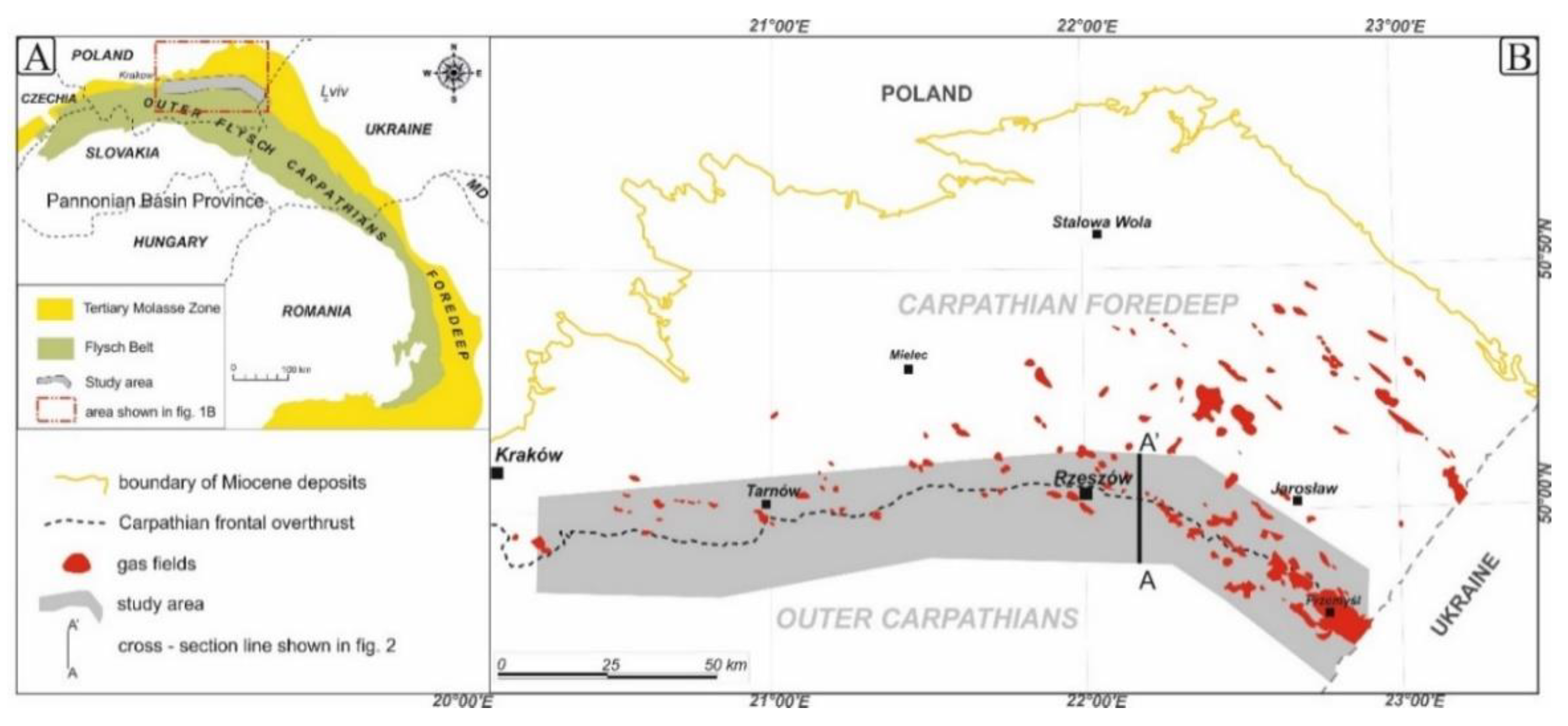
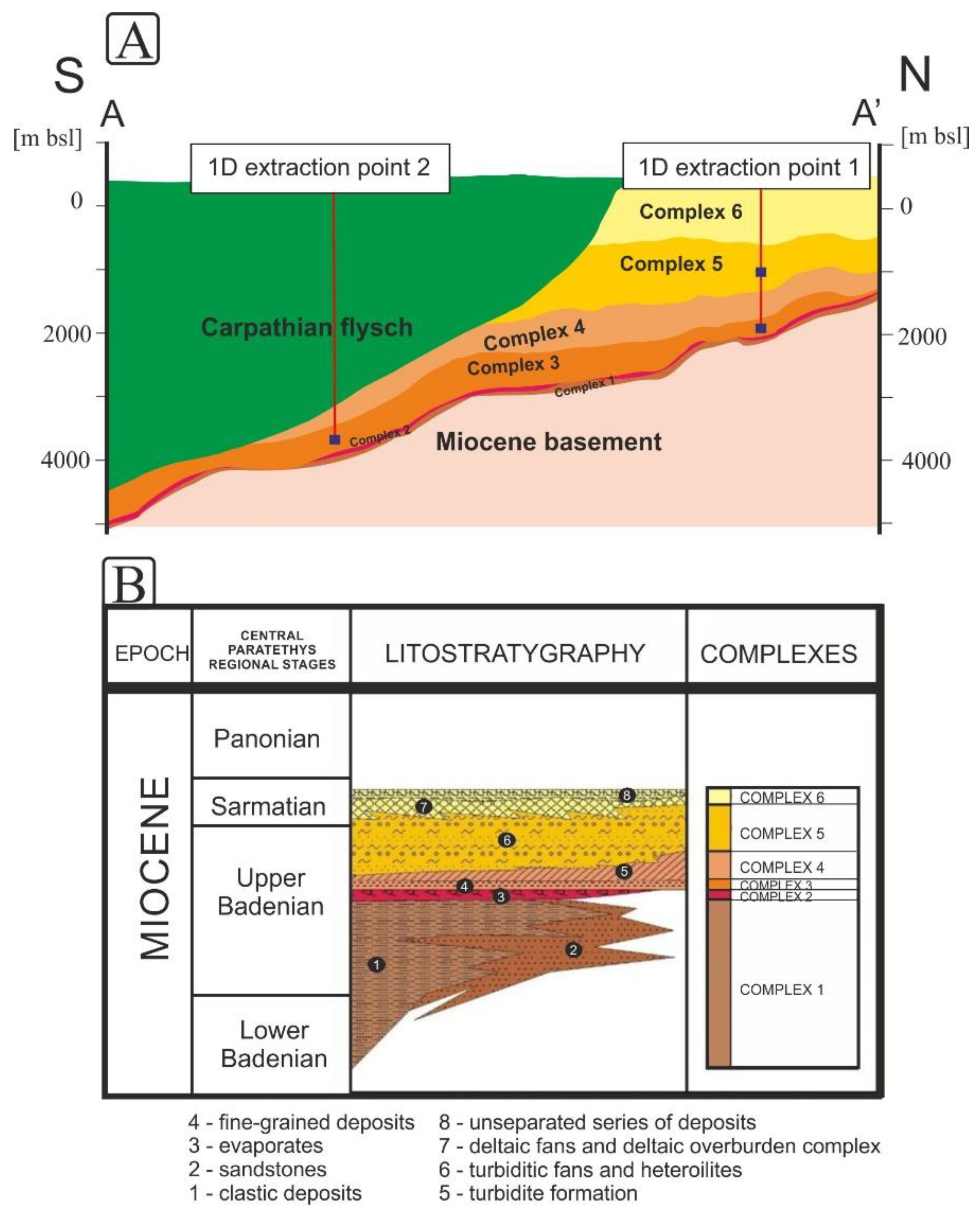
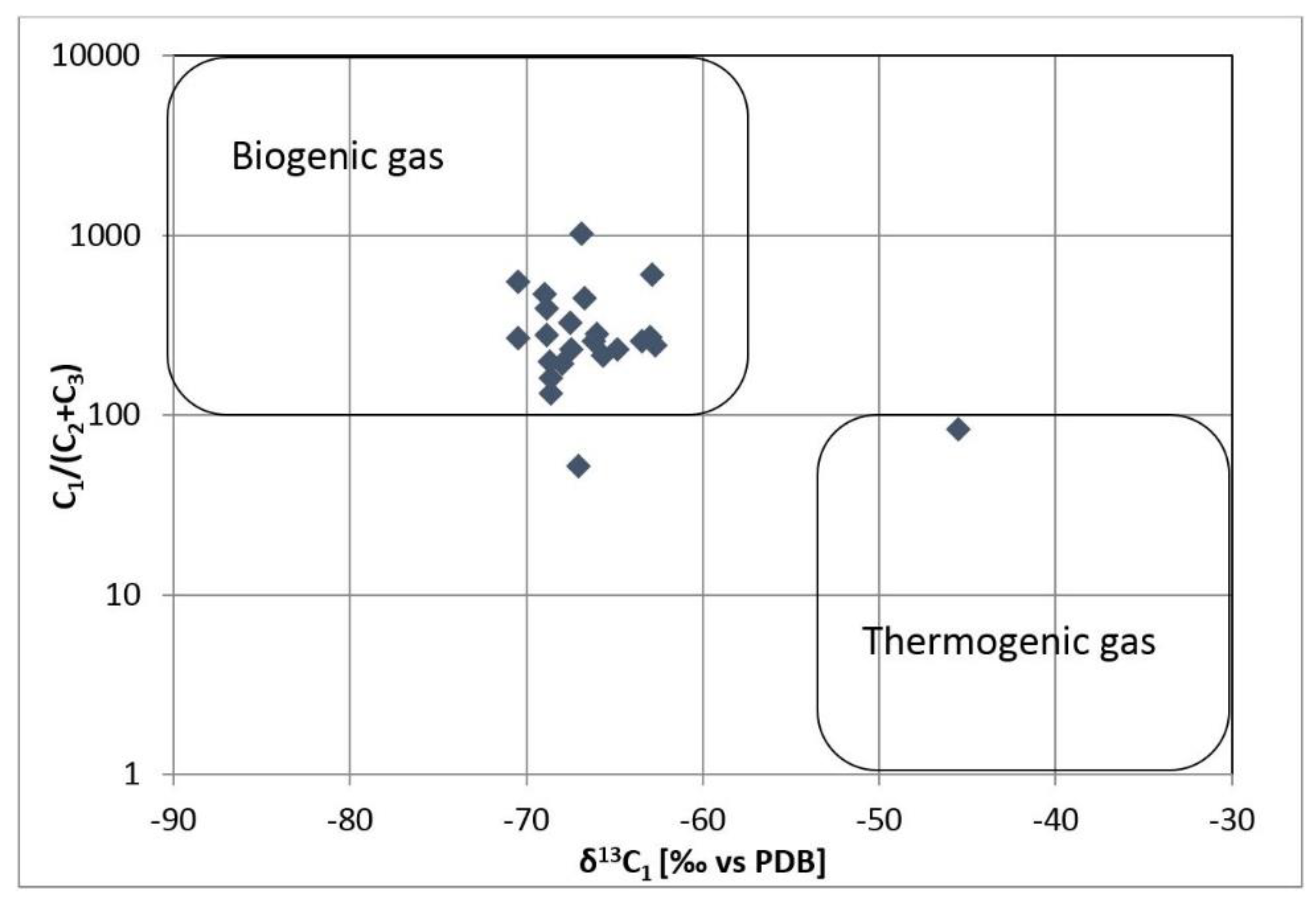


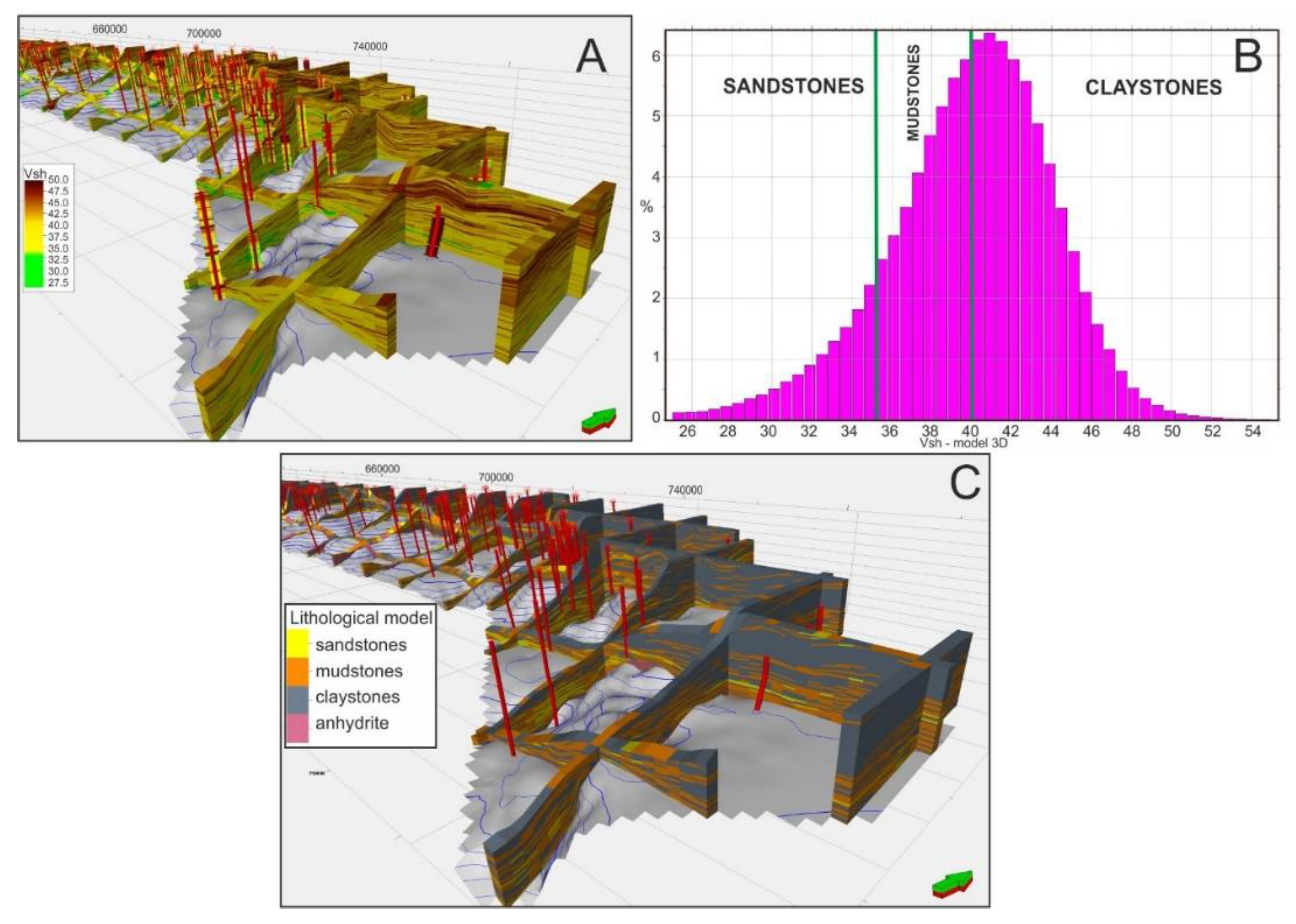
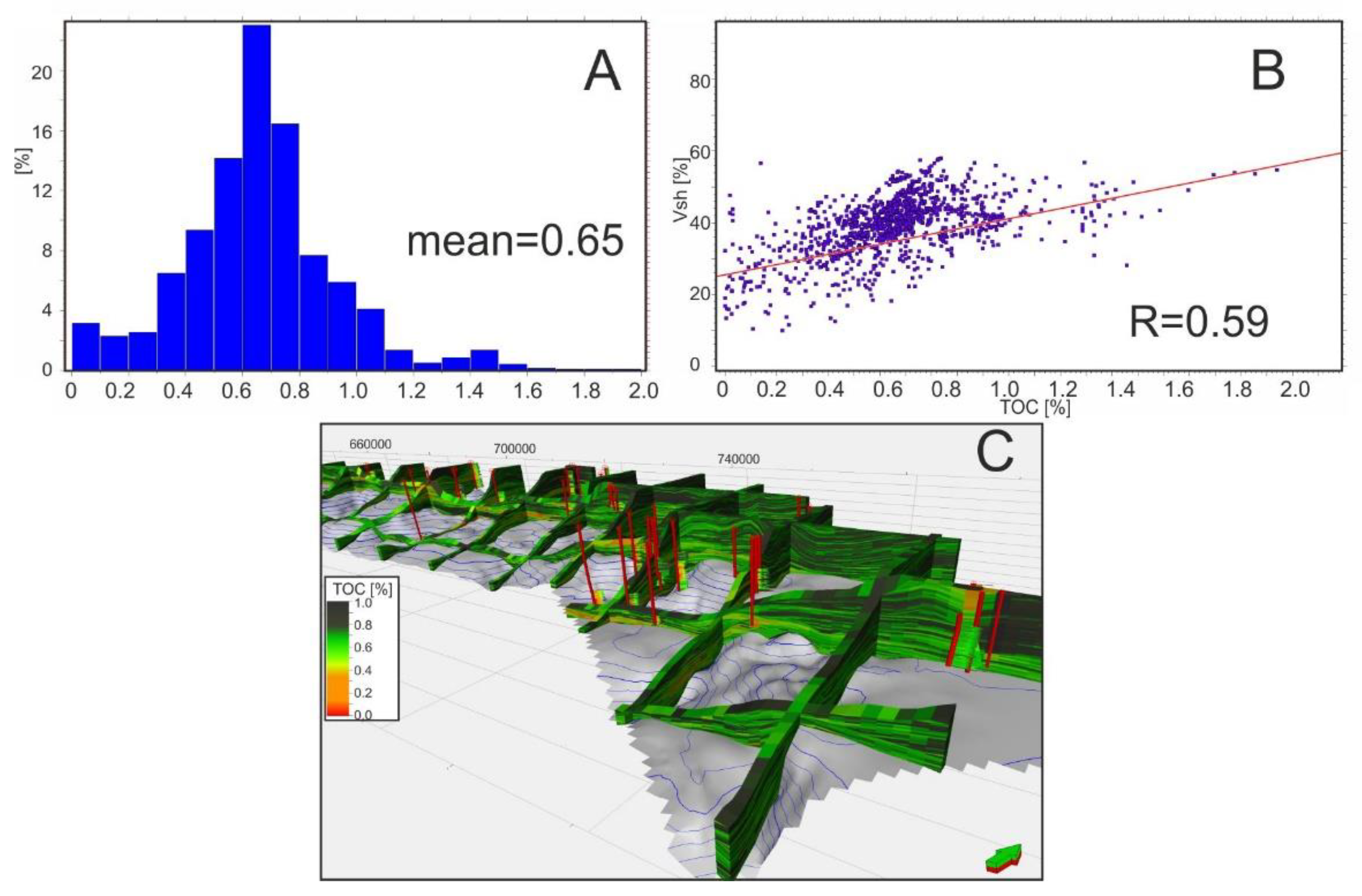
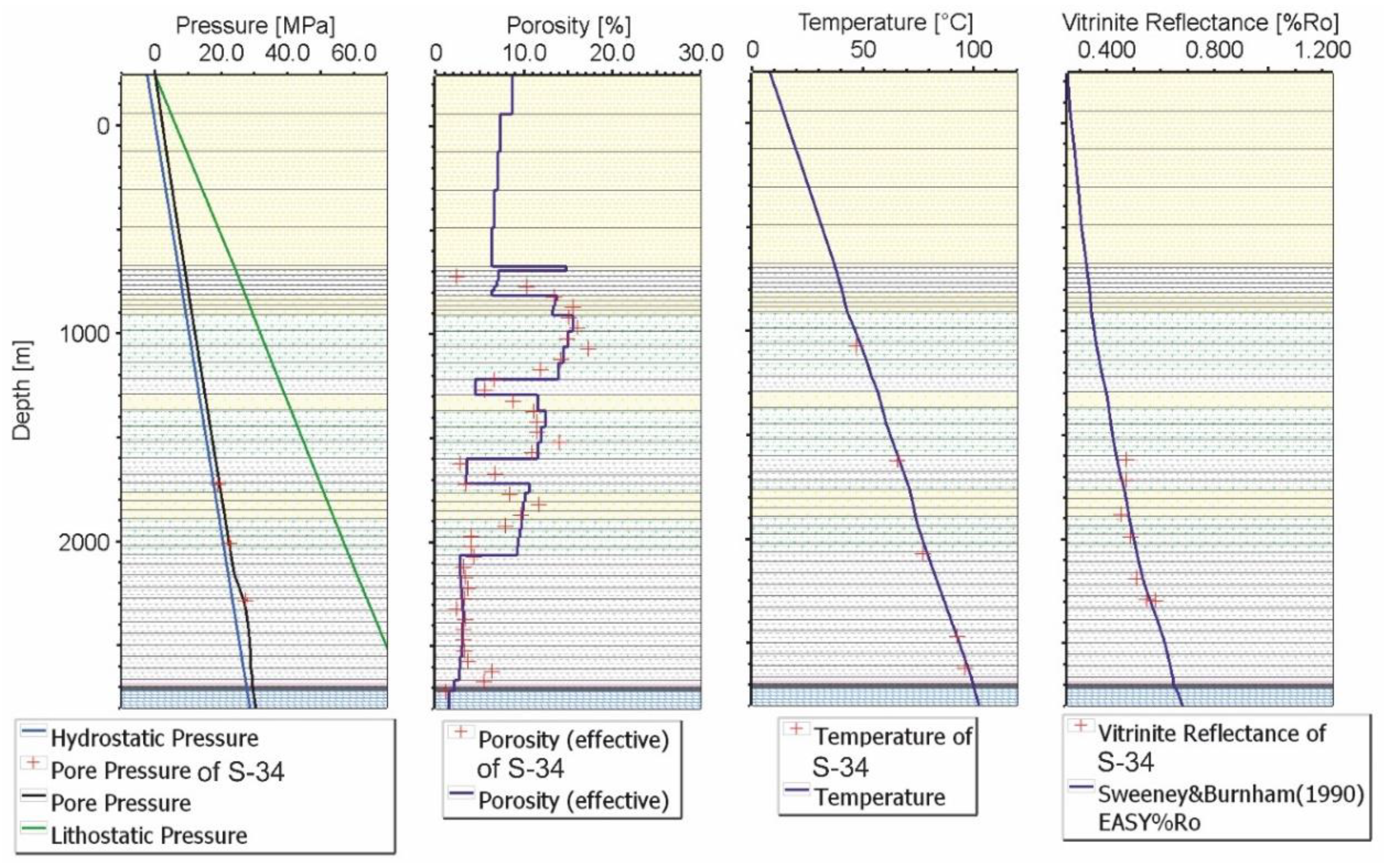
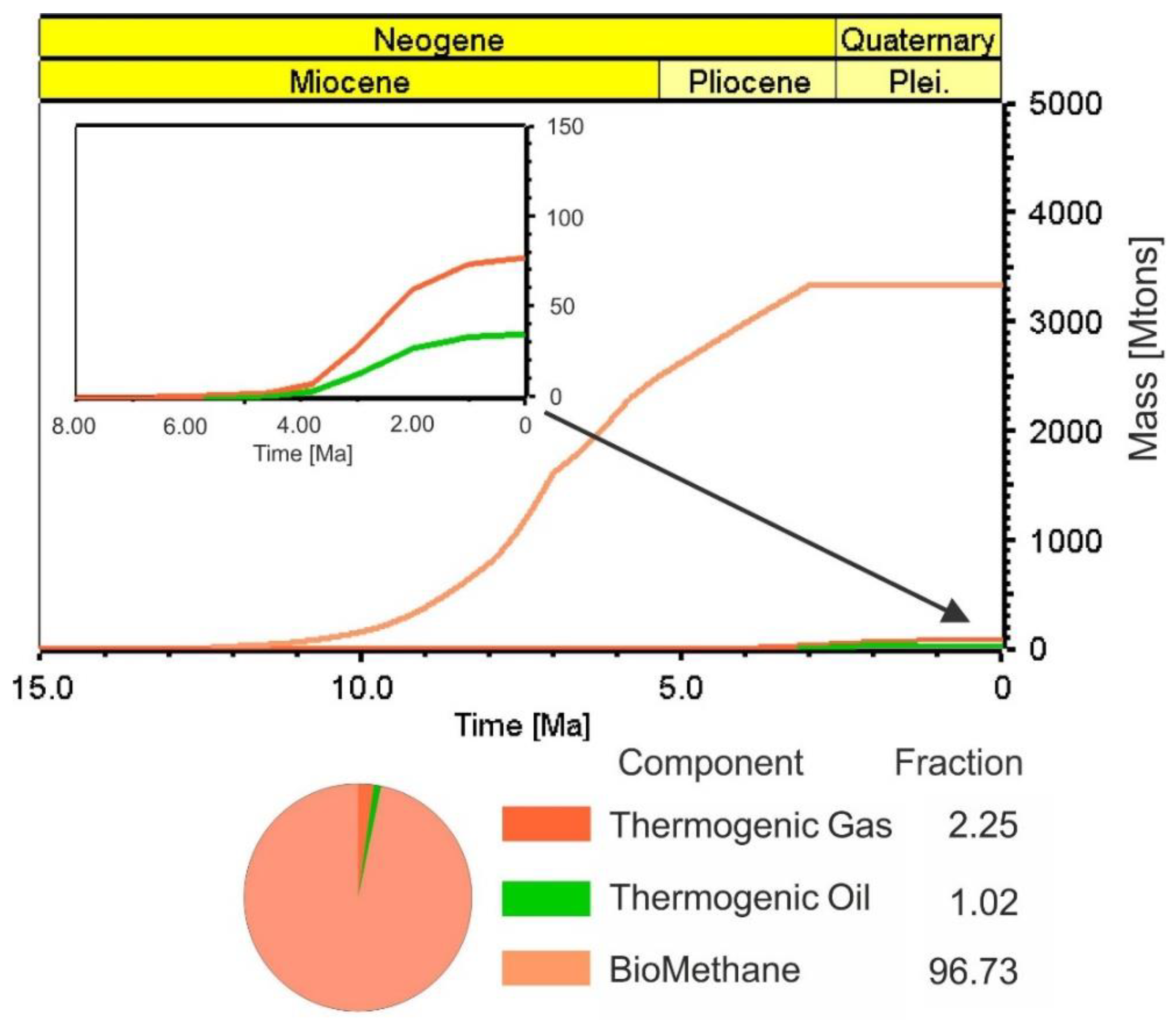
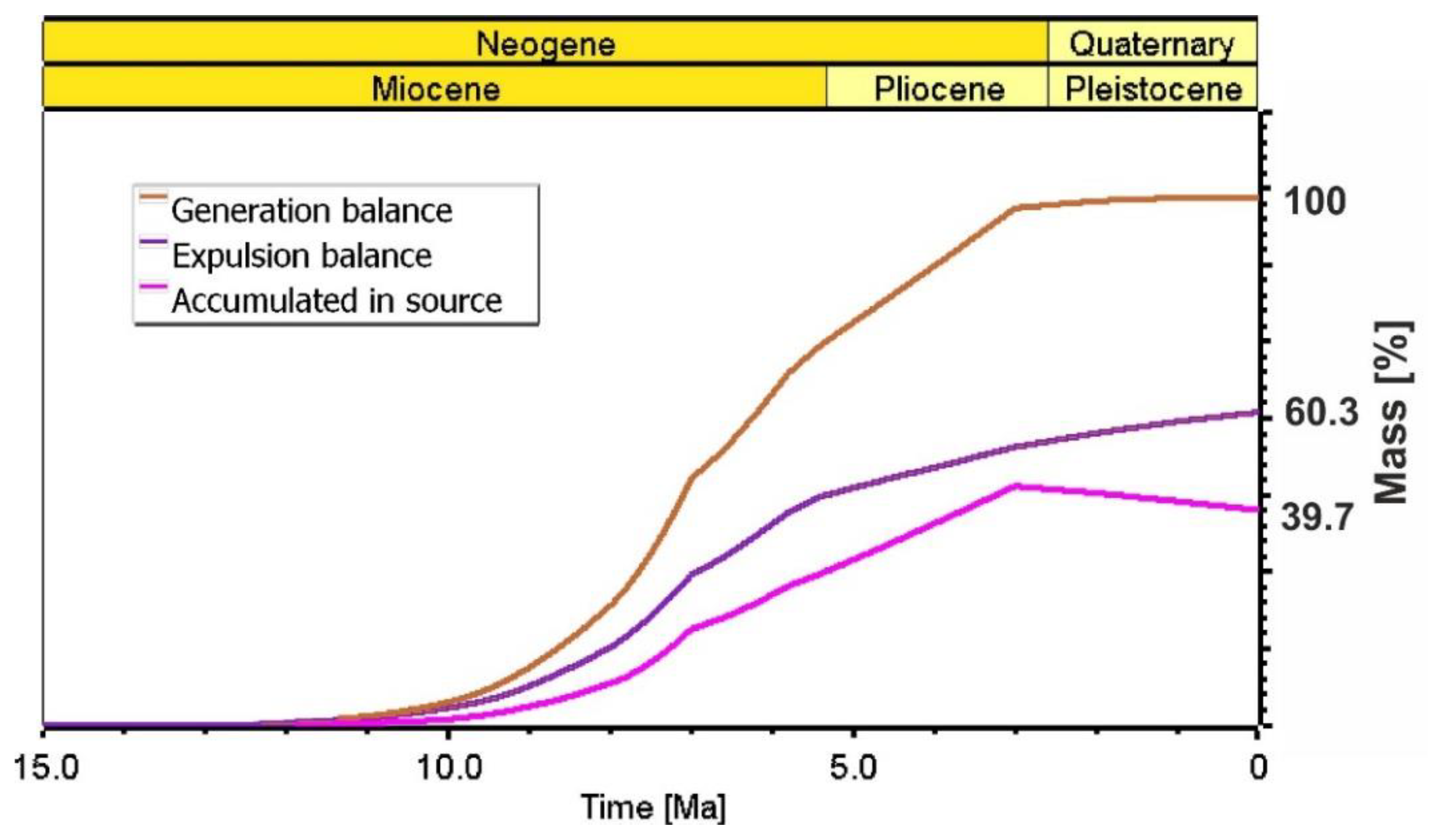
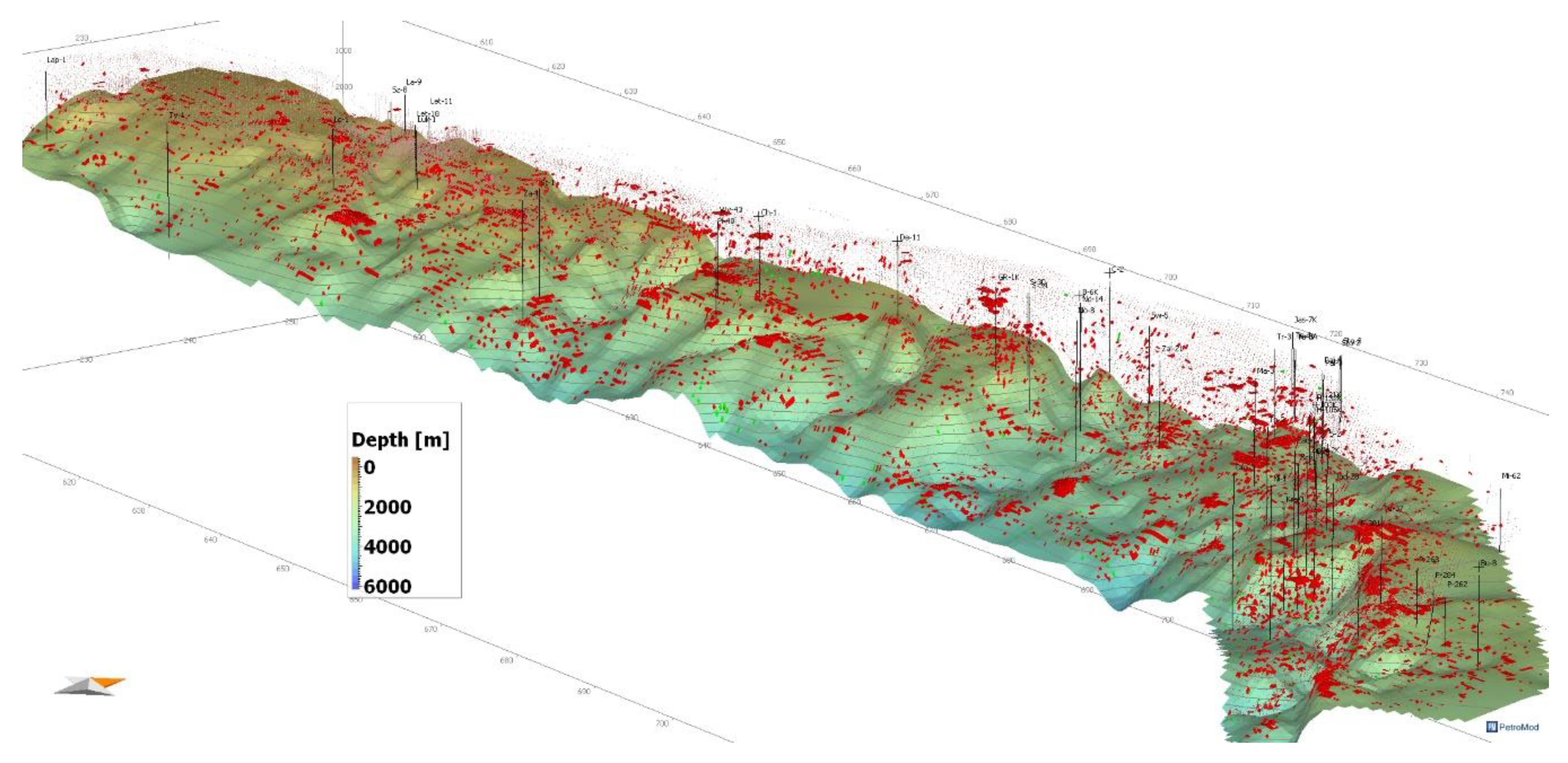
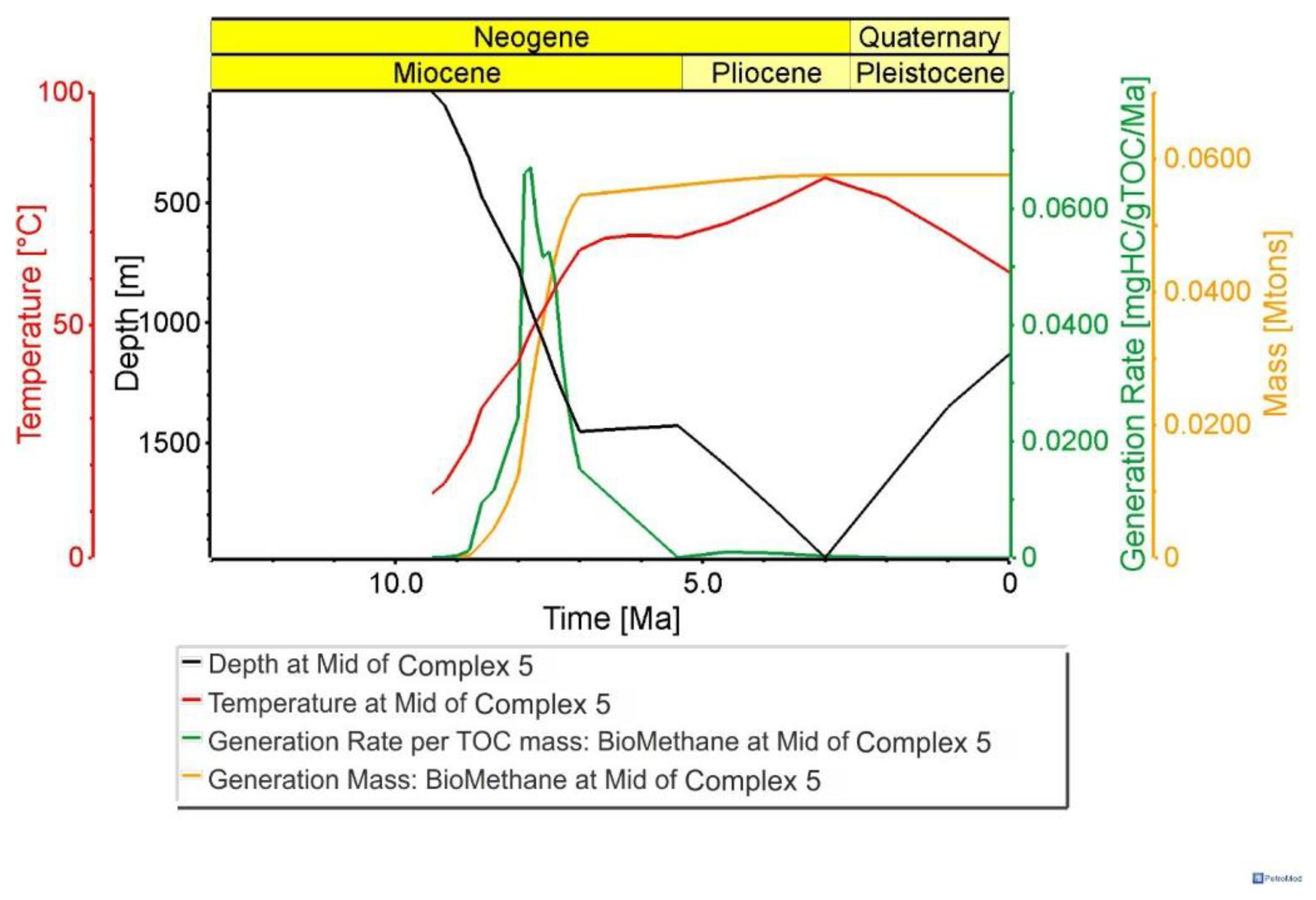
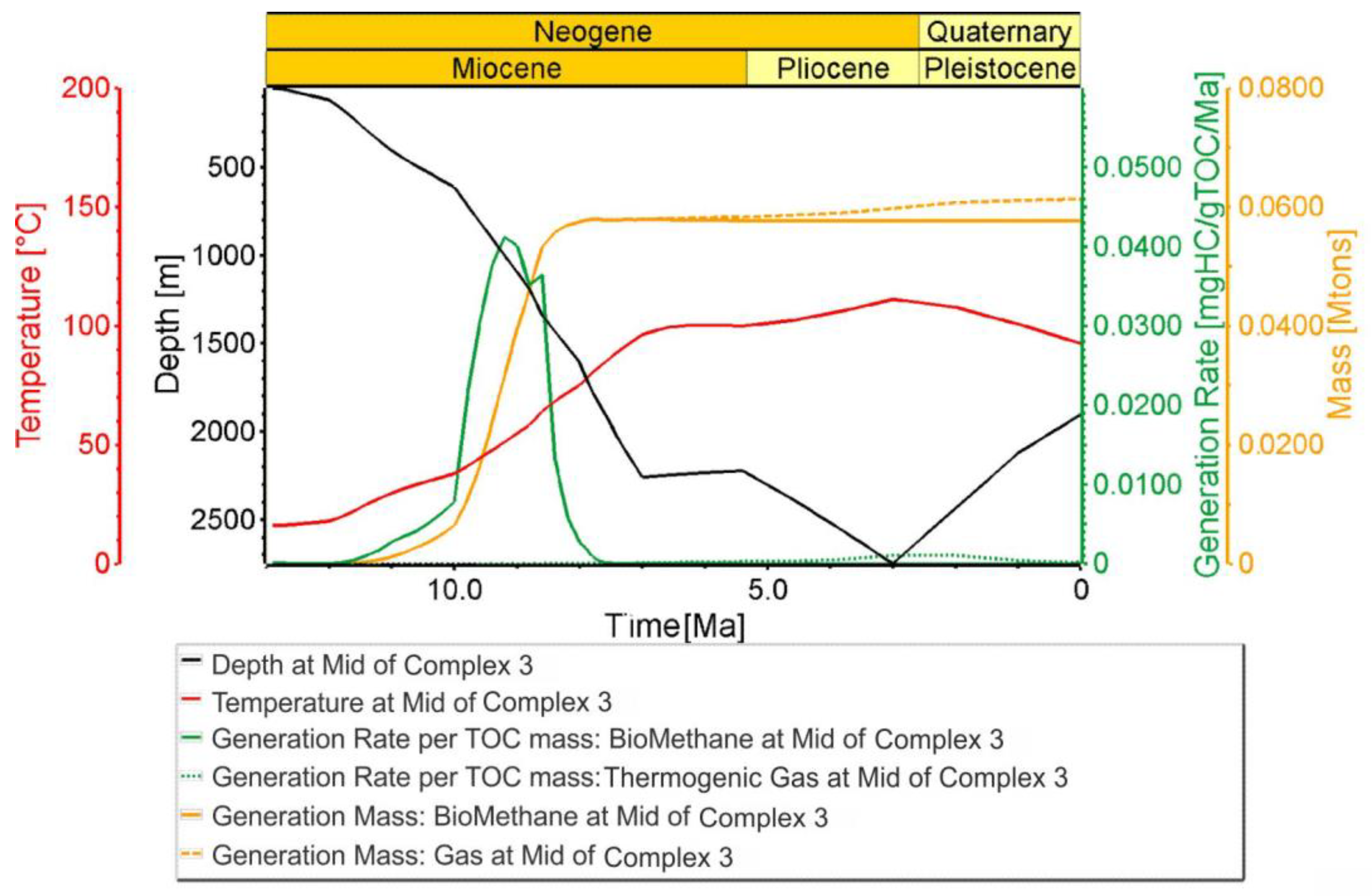
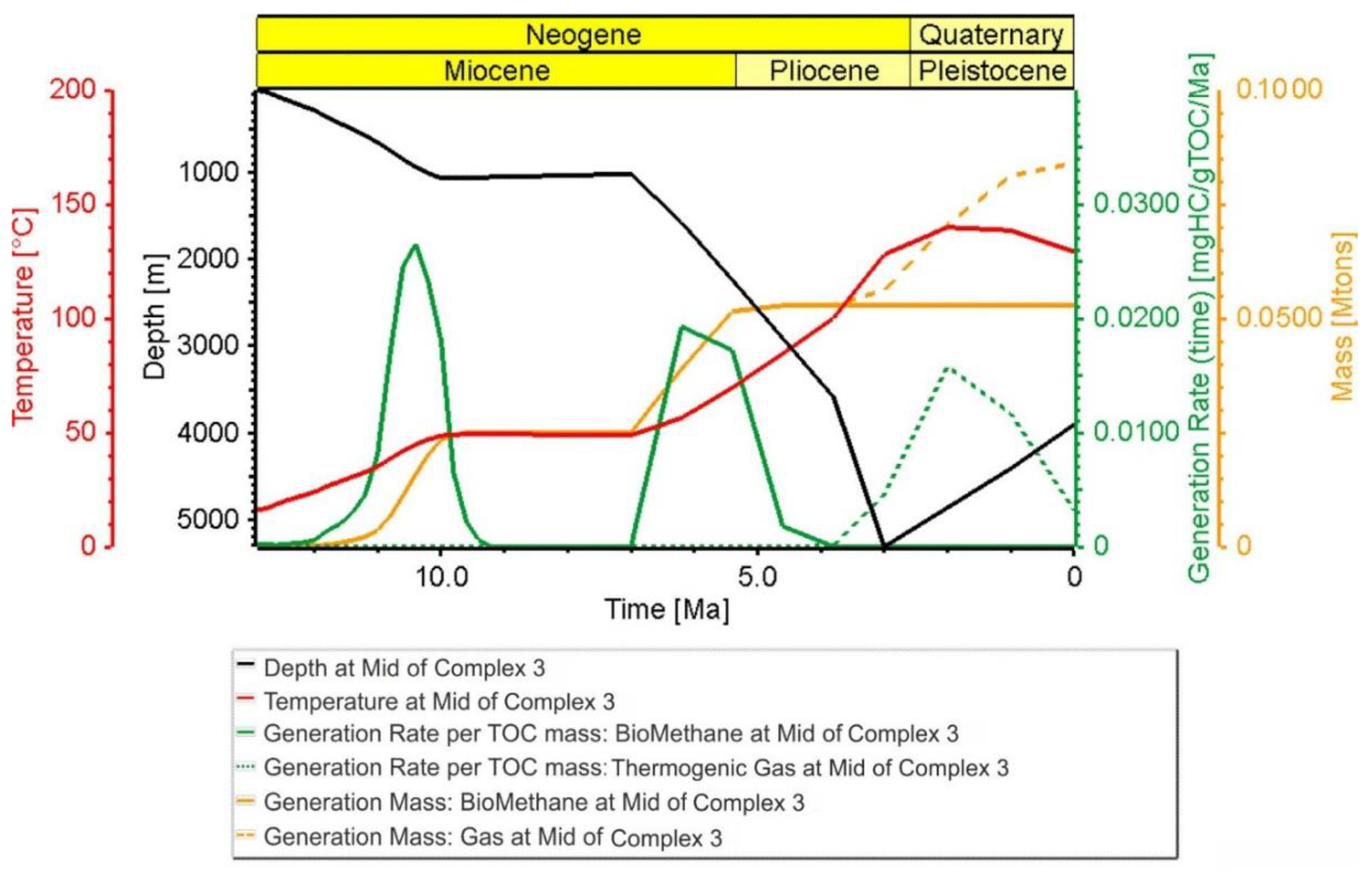
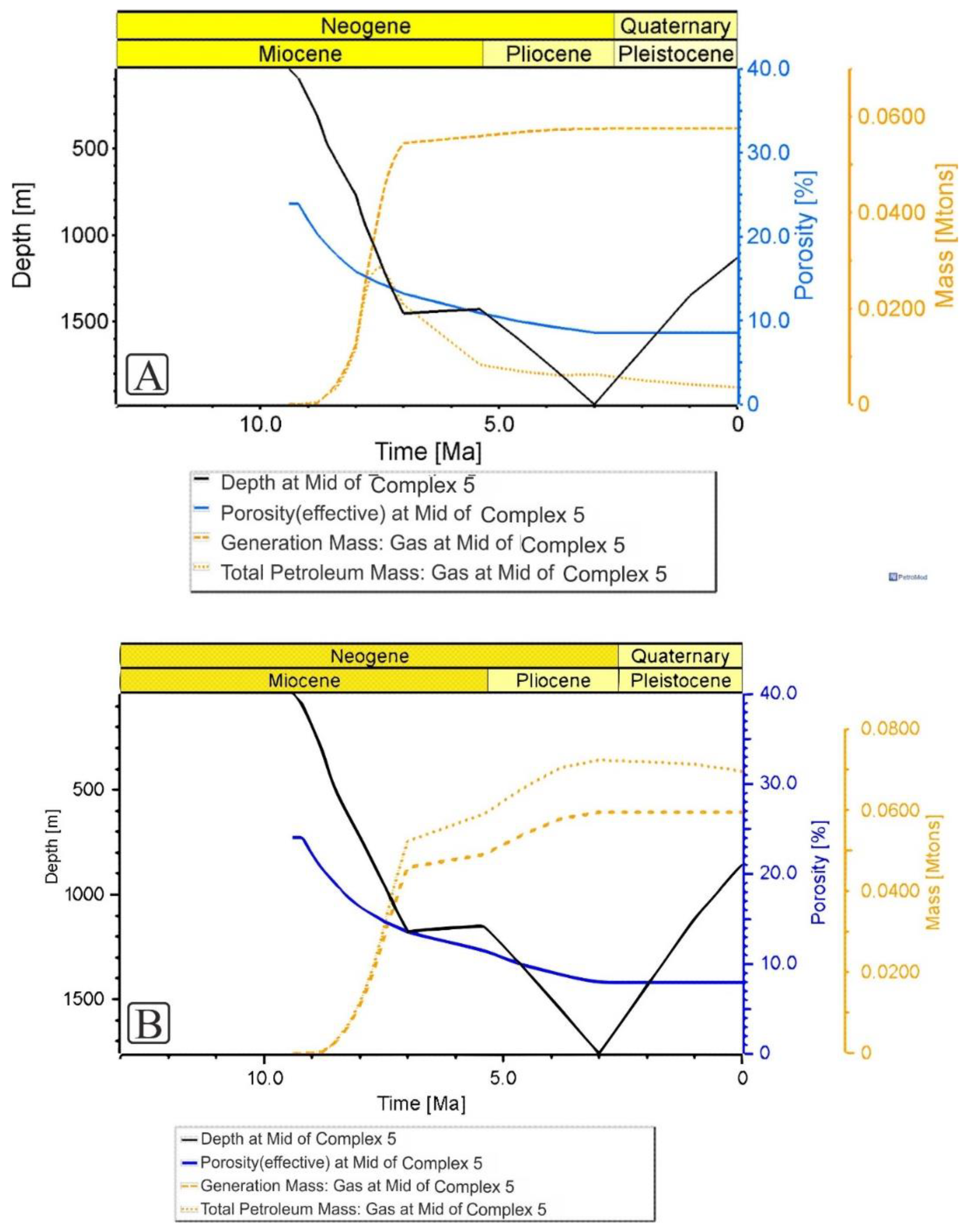
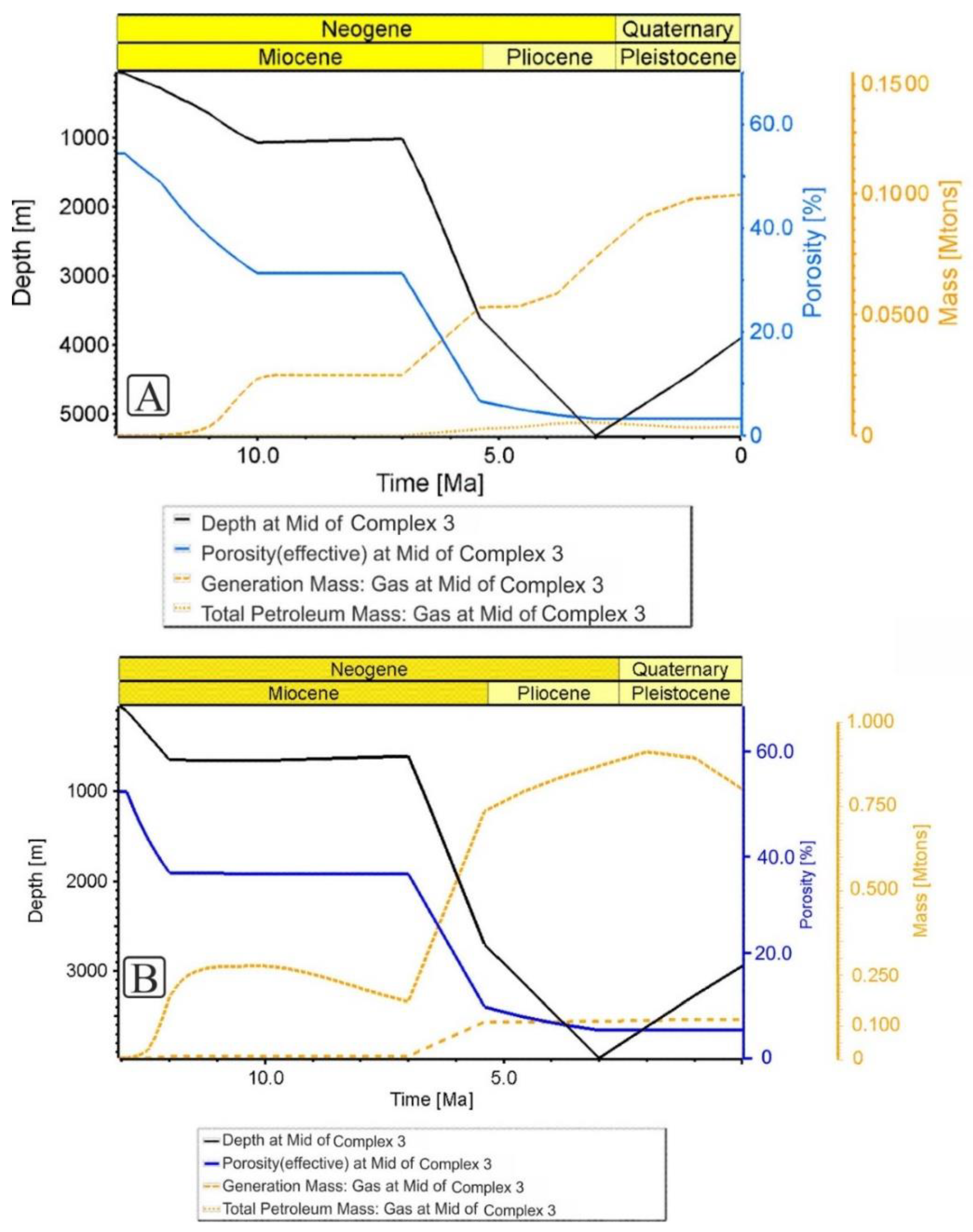
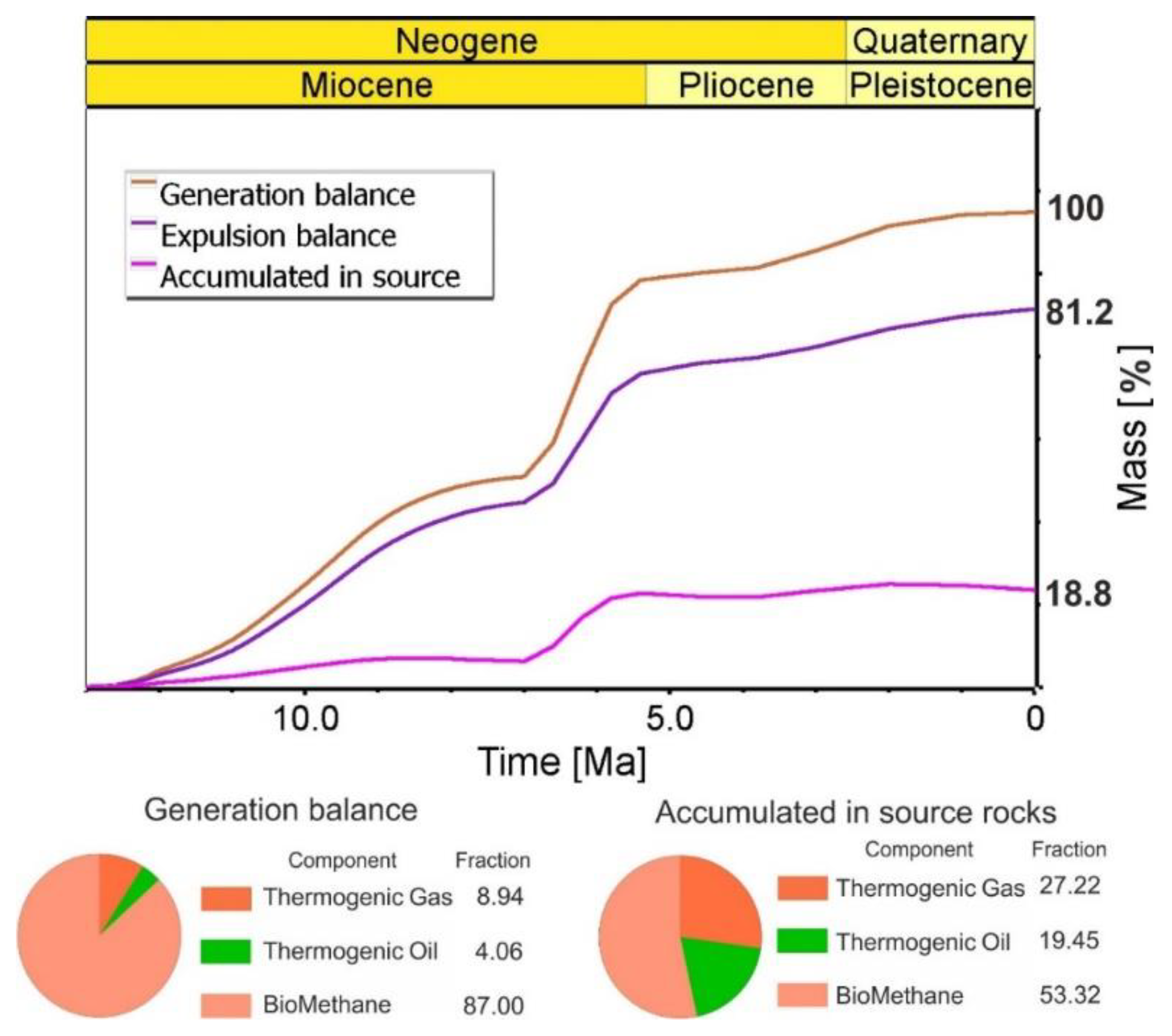

© 2020 by the authors. Licensee MDPI, Basel, Switzerland. This article is an open access article distributed under the terms and conditions of the Creative Commons Attribution (CC BY) license (http://creativecommons.org/licenses/by/4.0/).
Share and Cite
Sowiżdżał, K.; Słoczyński, T.; Sowiżdżał, A.; Papiernik, B.; Machowski, G. Miocene Biogas Generation System in the Carpathian Foredeep (SE Poland): A Basin Modeling Study to Assess the Potential of Unconventional Mudstone Reservoirs. Energies 2020, 13, 1838. https://doi.org/10.3390/en13071838
Sowiżdżał K, Słoczyński T, Sowiżdżał A, Papiernik B, Machowski G. Miocene Biogas Generation System in the Carpathian Foredeep (SE Poland): A Basin Modeling Study to Assess the Potential of Unconventional Mudstone Reservoirs. Energies. 2020; 13(7):1838. https://doi.org/10.3390/en13071838
Chicago/Turabian StyleSowiżdżał, Krzysztof, Tomasz Słoczyński, Anna Sowiżdżał, Bartosz Papiernik, and Grzegorz Machowski. 2020. "Miocene Biogas Generation System in the Carpathian Foredeep (SE Poland): A Basin Modeling Study to Assess the Potential of Unconventional Mudstone Reservoirs" Energies 13, no. 7: 1838. https://doi.org/10.3390/en13071838
APA StyleSowiżdżał, K., Słoczyński, T., Sowiżdżał, A., Papiernik, B., & Machowski, G. (2020). Miocene Biogas Generation System in the Carpathian Foredeep (SE Poland): A Basin Modeling Study to Assess the Potential of Unconventional Mudstone Reservoirs. Energies, 13(7), 1838. https://doi.org/10.3390/en13071838





